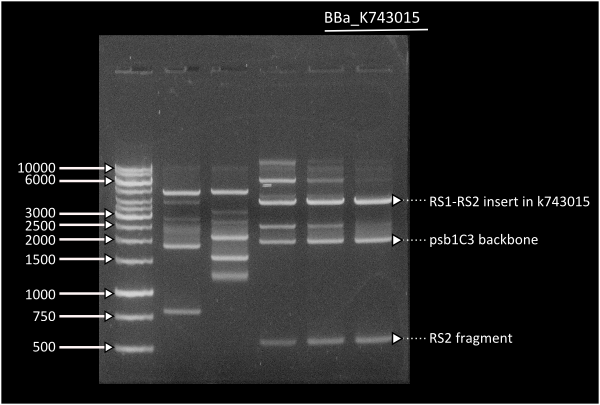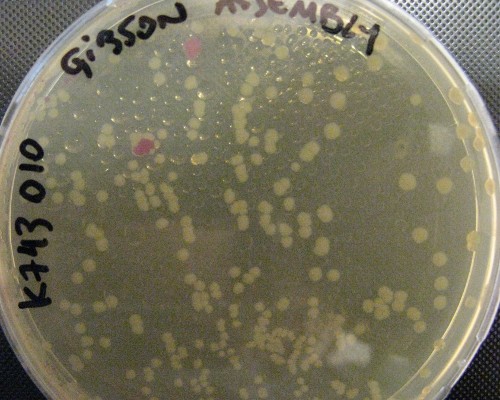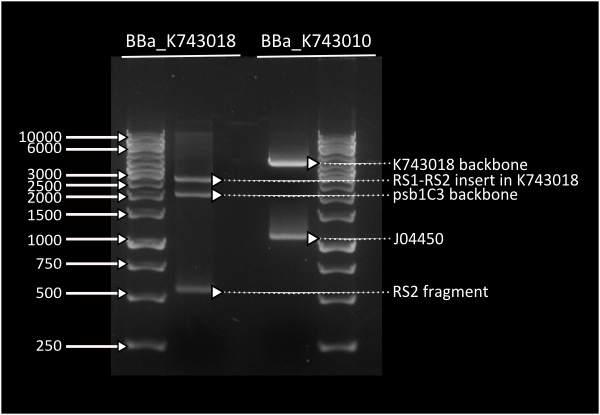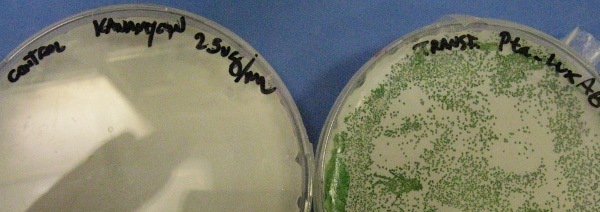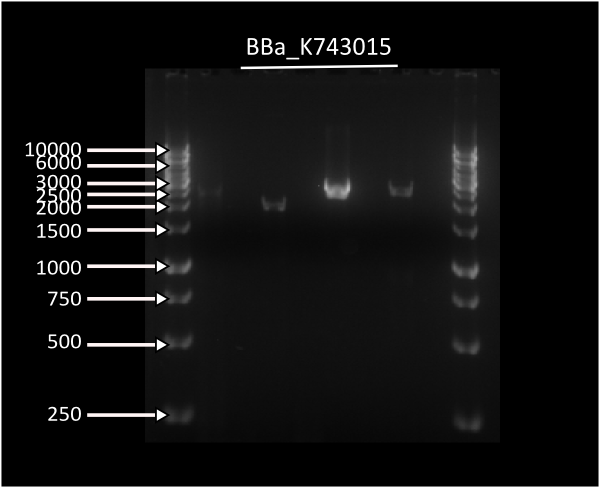Team:UC Chile/Cyanolux/Results
From 2012.igem.org

Contents |
Plasmid Construction
Following our experimental strategy we built two plasmid backbones on which to insert the Lux constructs.
Neutral recombination plasmid
 1st lane is 1Kb Ladder. 4th lane is C4; Band at 2300: Digestion intermediate, band at 2000: backbone, band at 1700: RS1-KanR-RS2partial, band at 500: RS2partial.
1st lane is 1Kb Ladder. 4th lane is C4; Band at 2300: Digestion intermediate, band at 2000: backbone, band at 1700: RS1-KanR-RS2partial, band at 500: RS2partial.
This plasmid backbone was constructed by standard assembly techniques. Recombination sites ([http://partsregistry.org/Part:BBa_K743000 BBa_K743000] and [http://partsregistry.org/Part:BBa_K743001 Part:BBa_K743001]) were Biobricked by Gibson assembly and were consenquently ligated to neighboring parts and KanRB0015 in parallel assembly. Afterwards, we ligated both composites through a standard assembly reaction. Final construct was validated by digestion (see gel image at right) and corroborated through sequencing.
After obtaining [http://partsregistry.org/Part:BBa_K743006 BBa_K743006], we proceeded assembling our constructs through Gibson assemblies.
If you are wondering why the plasmid was constructed by standard assembly and not by gibson assembly from scratch, please refer to Gibson assembly for small parts
Insertion of LuxAB genes
Starting from [http://partsregistry.org/Part:BBa_K743006| K743006] as a plasmid backbone, we were able to build our LuxAB constructs for the bacterial luciferase using two different versions available at the registry (from [http://partsregistry.org/Part:BBa_K743014 Photorhabdus luminiscent, BBa_K743014] and [http://partsregistry.org/Part:BBa_K743015 Vibrio fisherii, BBa_K743015]) under an endogenous Synechocystis's promoter (transaldolase Reference???). Resulting constructs were verified by digestion (see gel images below) and corroborated by sequencing.
Lane 1 = Ladder 1Kb, Lane 6 = K743014. Band at 4000: RS1-Pta-LuxABvf-Kan-RS2partial, band at 2000: pSB1C3, band at 500: RS2partial.
Lane 1 = Ladder 1Kb, Lane 3 = K743014. Band at 4000: RS1-Pta-LuxABxl-Kan-RS2partial, band at 2000: pSB1C3, band at 500: RS2partial.
Suceptibility construct
pSB1C3_IntS was constructed in two successive Gibson assemblies. The first assembly inserted the CopS region (the entire RS5 & RS6 recombination locus) to a chopped-down pSB1C3 lacking the whole VF2 to VR region. The second assembly inserted the Spectynomycin resistance selection marker and the whole VF to VR region of plasmid pSB4K5-J04450 right in between of the RS5 & RS6 CopS region. This construct yields red colonies if correctly assembled (see image at left). Red colonies were colony PCRed, verificated by digestion (see image down right) and corroborated by sequencing.
Insertion of Lux substrate biosynthesis genes under twilight promoters
We have amplified all the parts of the substrate production pathway ([http://partsregistry.org/wiki/index.php?title=Part:BBa_K325902 LuxCD] and [http://partsregistry.org/wiki/index.php?title=Part:BBa_K325903 LuxEG]) for the final construct under the Pcaa3 promoter (which has also been Biobricked with code http://partsregistry.org/wiki/index.php?title=Part:BBa_K743002 K743002. Also, we are amplifying one remaining part (LuxCD with 5' homology to PsigE) to do Gibson assembly of the LuxCDEG construct under PsigE. Gibson reaction will be done along with the substrate production construct under Pcaa3 in pSB1C3_IntS for both constructs.
Synechocystis PCC 6803
Transforming Synechocystis PCC 6803
Once constructs were corroborated by sequencing, we proceeded to transform synechocystis. Prior to transforming, we verified that our Synechocystis cultures were in exponential growth by comparison to our growth curve characterization.
Transformation in Synechocystis takes about two weeks to reveal transformant colonies, which in turn have to be restreaked again before PCR verification. This makes working in Synechocystis pressing as mistakes can take long to unravel.
This image shows various time points during a Synechocystis PCC. 6803 transformations. Be advised that it is only to be used as a reference of what to expect during the first week of transformation.
LuxABxl under transaldolase promoter transformation
Transformation of Synechocystis PCC 6803 with [http://partsregistry.org/wiki/index.php?title=Part:BBa_K743014 K743014] on the 14th day of transformation. The left plate is the control transformation plate (no DNA) on Kanamycin 25ug/mL and on the right, successfully transformed Synechocystis colonies growing throughout the Millipore membrane on the same antibiotic.
LuxABvf under transaldolase promoter transformation
Transformation of Synechocystis PCC 6803 with [http://partsregistry.org/wiki/index.php?title=Part:BBa_K743015 K743015] on the 14th day of transformation. The left plate is the control transformation plate (no DNA) on Kanamycin 25ug/mL and on the right, successfully transformed Synechocystis colonies growing throughout the Millipore membrane on the same antibiotic.
Corroboration of integration
To corroborate if the transformant colonies had integrated the actual insert, we did colony PCR for multiple parts contained in the insert.
Integration of LuxABxl under transaldolase promoter
We did a massive colony PCR to corroborate the presence of the parts which composed the original K743014 integration plasmid, with corresponding negative controls to avoid confusing a genomic amplicon with an insert amplicon.
Regretably we had many negative controls which had amplicons and also lots of amplicons of the insert which we could not obtain... We are not certain about the repercussions of this result so we will try the experiment after the wiki freeze.
Integration of LuxABvf under transaldolase promoter
This PCR was done using DNA from transformant LuxABvf colonies to amplify parts contained in the insert in lanes 2,4,6,8 and DNA from wild-type Synechocystis PCC 6803, used as a negative control in lanes 3,5,7,9. Ladder 1Kb is placed in lane 1 and 10.
We would like to make notice that to our knowledge we are the first iGEM team to do a succesful direct transformation of Synechocystis PCC. 6803 with naked DNA!
K743015 Debugging
sfGFP with degradation tag to characterize transaldolase promoter
To describe the circadian behaviour of the transaldolase promoter, we built a fast-degrading reporter consisting of sfGPF(I746916) with a LVA degradation tag in the C-terminal end of the protein, [http://partsregistry.org/Part:BBa_K743019 BBa_K743019]. This construct will serve as a real-time reporter of promoter activity. As it is a reporter plasmid with fast-degradation tags, verificating if sfGFP is being expressed circadianly by Synechocystis should be effortless.
You may find more information about the half-life of proteins with the LVA tag [http://partsregistry.org/wiki/index.php?title=Part:BBa_M0050 | here]. The construct has been verified by digestion and corroborated by sequencing. Check construct digestion Team:UC_Chile/Cyanolux/Results#C10 here
Due to unexpected results and recent information in the [http://partsregistry.org/Part:BBa_K325905 | registry page ] specifying as a failed experience.
 "
"
